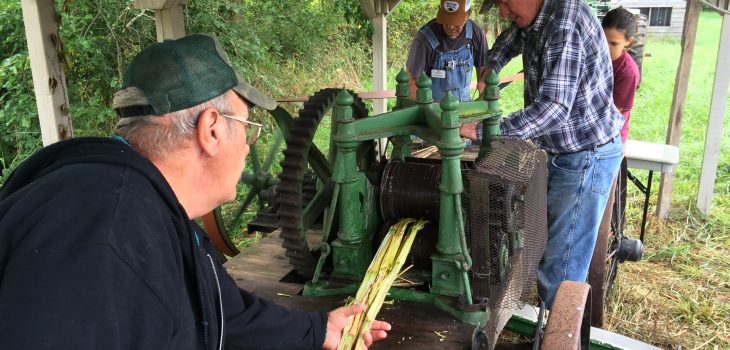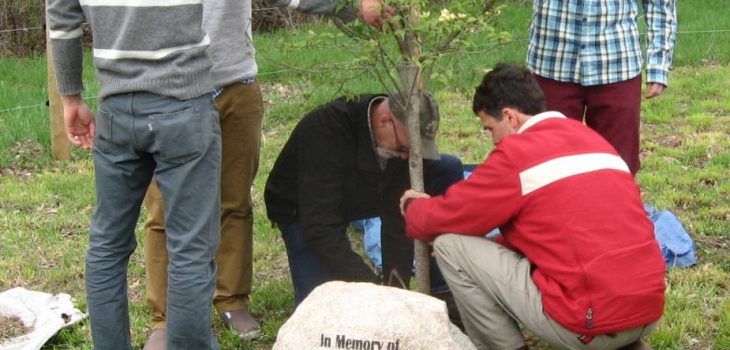Small Mammals
Research Students:
Tasha Brubaker
Manchester University ’22
Majors: Environmental Studies, Biology
Assisted by Tyler Hudson
Manchester University ’22
Major: Environmental Studies
WHAT IS THE RESEARCH?
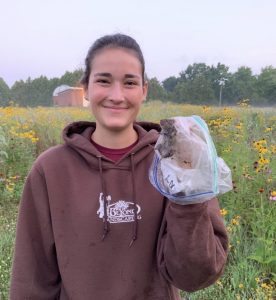 Tasha studied the population dynamics and habitat use of small mammals, specifically northern short-tailed shrews, mice and meadow voles. Because very little research has been done on northern short-tailed shrews, Tasha focused primarily on this species to better understand their preferred habitats. She hypothesized that shrews would be more abundant in ecotones (an area of transition between two habitats) between prairies and woods, because of the variety of microhabitat conditions present in these zones. Shrews need relatively wetter soil because they eat insects, unlike other small mammals which eat seeds.
Tasha studied the population dynamics and habitat use of small mammals, specifically northern short-tailed shrews, mice and meadow voles. Because very little research has been done on northern short-tailed shrews, Tasha focused primarily on this species to better understand their preferred habitats. She hypothesized that shrews would be more abundant in ecotones (an area of transition between two habitats) between prairies and woods, because of the variety of microhabitat conditions present in these zones. Shrews need relatively wetter soil because they eat insects, unlike other small mammals which eat seeds.
With help from Tyler, Tasha surveyed small mammal populations in six prairies using 150 – 160 traps baited with dried meal worms for the shrews and sunflower seeds for the mice and voles. When shrews and voles were captured, Tasha and Tyler trimmed off patches of their fur so that previously captured individuals could be identified and the size of their populations could be more accurately calculated. Fur samples were also sent to a lab at Manchester University where other students and faculty researchers examined the DNA to determine if the populations are inbreeding.
HOW WILL THIS RESEARCH INFORM OR IMPACT MERRY LEA?
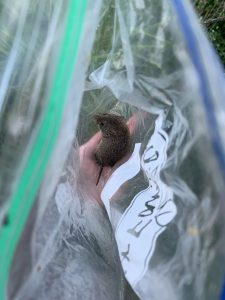 The number of different small mammal species and individuals can indicate the health of Merry Lea’s ecosystems, particularly prairies. Small mammals are important for keeping these ecosystems healthy: they help distribute seeds, fertilize soils and are prey for larger animals.
The number of different small mammal species and individuals can indicate the health of Merry Lea’s ecosystems, particularly prairies. Small mammals are important for keeping these ecosystems healthy: they help distribute seeds, fertilize soils and are prey for larger animals.
This research will also inform Merry Lea’s habitat connectivity management: how well animal movement and other ecological processes occur across landscapes. For example, if there is a high degree of inbreeding, that could indicate poor habitat connectivity as populations might be too isolated from each other.
Thus, this data could inform how land management practices currently impact small mammals and which practices could be used to improve the populations. According to Tasha, reseeding areas with native prairie plants could be one technique for bolstering shrew populations. Plant diversity affects soil health, which then impacts insects- the most important food source for shrews- and other foods.
WHAT IS THE DAY-TO-DAY LIKE?
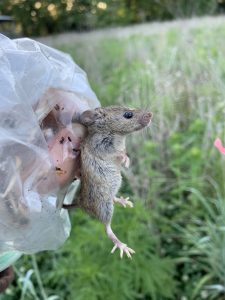 Mornings:
Mornings:
Each morning started in the field at 6 or 6:30 a.m., depending on the temperature, to check traps.
If any small mammals were captured, they were placed in a clear bag for processing and to prevent disease transmission.
They determined the species, sex and weight of individual animals and a patch of fur was trimmed. Hairs were collected before being released.
All traps were kept closed during the heat of midday to avoid animals entering the metal traps heated by the sun.
Evenings:
In late afternoon, the doors of all traps were opened again and bait was restocked. They made sure the traps were insulated with foliage to prevent the traps from getting too hot or cold.
The traps then stayed open all night before being checked again the next day.
WHAT ARE YOU HOPING TO DO WITH THIS RESEARCH?
One of the reasons why natural history data on northern short-tailed shrews is so sparse, is because they can be difficult to capture and keep alive. Because shrews have high metabolisms, they need to eat every few hours, which can prove difficult if they’re stuck in a trap for too long before researchers can release them. Tasha used a unique trap baiting technique by including meal worms as a food source for the captured shrews, which greatly reduced the mortality rate of these animals. Tasha hopes to publish her research highlighting this trapping technique to spur future studies on shrews especially.

